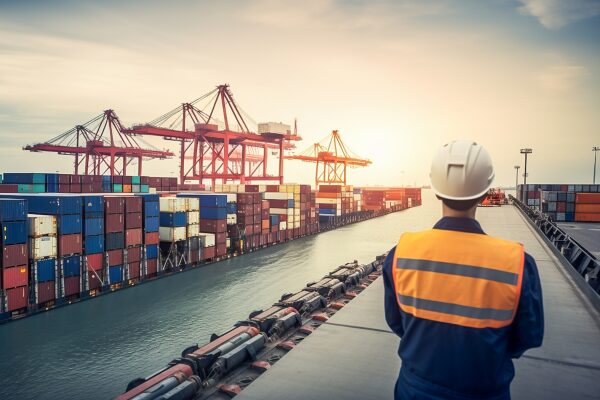8 Ways Supply Chain Companies Can Navigate New Trade Tariffs

February 3, 2025
The US trade landscape is facing some reshuffling as new tariffs are being imposed on goods from key trading partners. These tariffs could significantly increase costs on imports, with a 25% duty levied on Mexico and Canada, and a 10% tariff imposed on China.
These changes have businesses across the United States, particularly those relying on global supply chains, re-evaluating their strategies. These tariffs have the potential to significantly impact industries such as grocery, construction, automotive, among others, which often source components or finished goods from these countries.
Though tariff parameters seem to be changing daily at this point, understanding the impact and developing mitigation strategies are crucial for preparation, navigating the evolving trade environment, and maintaining a competitive edge in the US market.
How do Tariffs Impact the Economy?
Tariffs, essentially taxes on imported goods, can significantly alter the cost of products and the flow of global trade. They can impact everything from raw materials sourcing and manufacturing locations to final product pricing and consumer demand. The potential effects of new tariffs are rippling through various industries, creating both challenges and opportunities for businesses. For companies that rely on imported components or finished goods, tariffs can lead to increased costs, potentially squeezing profit margins and forcing price adjustments. Conversely, tariffs might create opportunities for domestic producers or businesses that have diversified their sourcing.
The uncertainty surrounding the specifics of these tariffs makes planning a complex endeavor. Businesses are grappling with questions about which products will be affected and the magnitude of the tariffs. This ambiguity underscores the need for flexible and adaptable supply chain strategies.
Tariff Mitigation Strategies
While the full impact of new tariffs remains to be seen, businesses can take proactive steps to mitigate supply chain disruptions and potential negative consequences down the line:
- Diversify Sourcing: Reducing reliance on a single supplier or country can help minimize the impact of tariffs. Exploring alternative sourcing options, both domestically and internationally, can provide a buffer against price increases and supply disruptions. This may involve identifying new suppliers, negotiating contracts, and adjusting logistics networks.
- Analyze Cost Structures: A thorough analysis of cost structures is essential to understand how tariffs might affect profitability. This involves evaluating the cost of imported materials, manufacturing, transportation, and other related expenses. By understanding the potential impact on each stage of the supply chain, businesses can make informed decisions about pricing and sourcing.
- Optimize Inventory Management: Strategic inventory management can help mitigate the effects of tariffs. Depending on the anticipated impact, businesses might consider increasing inventory levels before tariffs take effect to avoid price increases. Conversely, they might choose to reduce inventory to minimize potential losses if demand declines due to higher prices.
- Renegotiate Contracts: Businesses should review existing contracts with suppliers and customers to assess how tariffs might impact pricing and delivery terms. Renegotiating contracts to incorporate tariff-related contingencies can help protect against unforeseen costs.
- Explore Free Trade Zones and Foreign Trade Zones: Utilizing free trade zones (FTZs) or foreign trade zones (FTZs) can offer potential benefits by reducing or eliminating tariffs on goods that are processed, stored, or manufactured within these zones. This can be a valuable strategy for businesses involved in international trade.
- Consider Nearshoring or Reshoring: For some businesses, the prospect of tariffs might accelerate the trend toward nearshoring or reshoring production. Bringing manufacturing closer to home can reduce reliance on international supply chains and potentially mitigate the impact of tariffs. However, this decision requires careful consideration of factors such as labor costs, infrastructure, and regulatory environment.
- Embrace Technology: Leveraging technology can play a crucial role in navigating the complexities of tariffs. Advanced analytics and supply chain management software can provide real-time visibility into inventory levels, transportation costs, and potential disruptions. This information can help businesses make informed decisions about sourcing, pricing, and logistics.
- Stay Informed and Adaptable: The trade landscape is constantly evolving, so staying informed about policy changes is essential. Businesses should monitor developments closely and be prepared to adapt their strategies as needed. Flexibility and agility will be key to navigating the challenges and opportunities presented by new tariffs.
A Note About Inventory Management
Inventory management in times like these can be a slippery slope. Companies may opt to reduce shipping costs by placing larger frequent orders versus a more frequent replenishment model. Consumers may over-purchase for fear of future price increases, leading to a spike in demand for suppliers and manufacturers that doesn’t reflect long-term consumption patterns. These distorted signals travel up the supply chain and result in overproduction, excess inventory, and increased holding costs—leading to the phenomenon called “The Bullwhip Effect.”
While there may be no perfect solution for all businesses to avoid this phenomenon, adopting strategies like leveraging predictive analytics and AI, streamlining ordering practices and adopting agile inventory management can certainly be helpful.
Adapting as One in a Changing Trade Landscape
The implementation of new trade tariffs presents both challenges and opportunities for businesses. By taking proactive steps to diversify sourcing, analyze costs, optimize inventory, and leverage technology, companies can mitigate potential negative impacts and position themselves for success in the evolving global trade environment.
Staying informed and adaptable will be crucial for navigating the uncertainties ahead and thriving in the face of change, and TrueCommerce is here to help. Connect with our experts today to discuss the right strategies for your business.
Share this post:
Categories
Stay ahead of the competition
Get expert supply chain insights delivered directly to your inbox weekly.